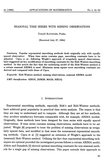Article
Full entry |
 PDF
(1.6 MB)
Feedback
PDF
(1.6 MB)
Feedback
 PDF
(1.6 MB)
Feedback
PDF
(1.6 MB)
Feedback
Keywords:
Holt-Winters method; missing observations; seasonal ARIMA model
Holt-Winters method; missing observations; seasonal ARIMA model
Summary:
Popular exponential smoothing methods dealt originally only with equally spaced observations. When time series contains gaps, smoothing constants have to be adjusted. Cipra et al., following Wright’s approach of irregularly spaced observations, have suggested ad hoc modification of smoothing constants for the Holt-Winters smoothing method. In this article the fact that the underlying model of the Holt-Winters method is a certain seasonal ARIMA is used. Minimum mean square error smoothing constants are derived and compared with those of Cipra.
References:
[1] B. Abraham, J. Ledolter: Forecast functions implied by autoregressive integrated moving average models and other related forecast procedures. International Statistical Review 54 (1986), 51–66. DOI 10.2307/1403258 | MR 0959652
[2] B. Abraham, J. Ledolter: Statistical Methods for Forecasting. Wiley, New York, 1983. MR 0719535
[3] M. Aldrin, E. Damsleth: Forecasting non-seasonal time series with missing observations. Journal of Forecasting 8 (1989), 97–116. DOI 10.1002/for.3980080204
[3] P.J. Brockwell, R.A. Davis: Time Series Theory and Methods. Springer, New York, 1991. MR 1093459
[5] T. Cipra, A. Rubio, J. Trujillo: Holt-Winters method with missing observations. Management Science.
[6] D.J. Wright: Forecasting data published at irregular time intervals using an extension of Holt’s method. Management Science 32 (1986), 499–510. DOI 10.1287/mnsc.32.4.499

